Back in 2013, Geoff Paradise, Owen Webb, Gary Myers, David Cook and the Taverna brothers paid tribute to the legendary Melbourne street machiner John Taverna after his sudden passing in August that year. Here’s a look back at how they bid him farewell, as first published in the October 2013 issue of Street Machine.
GEOFF PARADISE
IT WAS a hot Saturday afternoon 40 years ago. I was fiddling with my ’56 Chev in my modest one-car garage on Sydney’s lower North Shore when the rumble of a barely muffled V8 made me look up in time to watch a black ’57 idle by.
Five minutes later this bodgie in black jeans and check shirt, grinning like a mischievous Cheshire cat, strolled down the driveway. I didn’t have a clue who he was but he knew me.
“You Geoff?” he enquired in a way that suggested he wasn’t from around here. “I heard you’ve started a club for ’55-’57 Chevs and I thought I’d come up and see what it’s all about.”
It seems the bodgie — real name John Taverna — had read a news item in the long-defunct Australian Hot Rodding Review about the formation of the club and was keen to know more.
Taverna started his racing in the 60s with a ’57 Chev streeter. Things got serious when he and racing partner Phil Facciolo put the Chev’s 327 in the Grot FJ
Back then he was a line worker at Ford, which I thought was odd for a bloke driving a ’57, but it mattered not. He was keen as mustard and, I think, for a while our sole interstate member.
He was down to earth, funny and really knew his shit when it came to cars. How could I not like this guy who drove all the way from Melbourne (in the 70s that was a world away) just to suss out the 55-56-57 Chevrolet Club of Australia?
The second Grot was an HK Monaro that delivered JT and Phil Facciolo’s first meeting win, at the 1977 Sportsnationals at Calder Park
And so it was, spasmodically but never regularly, for the next 40 years we would talk at car shows, Summernats, the dragstrip or on the phone.
But now there’ll be no more hour-long phone calls or revving each other up when we meet. No more in-depth analysis of street machines, muscle cars, race cars or the last road trip in the US.
John Taverna — JT or Wog Boy, as I would call him in the way only long-time mates can — has left us way too soon.
He accomplished plenty, left some great legacies and will long be remembered by those lucky enough to have known him. That summer Saturday arvo on the driveway seems like yesterday. Adios amigo!
The first Ford Taverna built was this ’68 Mustang fastback, inspired by seeing Steve McQueen fanging one around San Francisco in Bullitt. We featured it in April/May ’97
OWEN WEBB
SATURDAY morning, 3 August, I woke to the sad news of the passing of my great mate John Taverna. He had been unwell for several months but nothing prepares you for that call.
John was a true pioneer and innovator of the drag racing and custom car industries.
We’ve lost a few legends recently and I want to make sure they’re remembered for their contributions and achievements. For that reason, from Summernats 27 the Master Craftsman trophy will be renamed The John Taverna Memorial Award. He was, after all, a master craftsman.
I met John in the 80s. He was a brash, loud and energetic guy, full of life and endless ideas for cars. And he actually built all these innovative machines. His business, John Taverna Chassis, started with chassis and fabrication work for drag cars until he crossed it over into what would become Pro Street, creating chassis, tubs, ’cages and powerful engines for street cars.
He always thought outside the square; whenever it was ‘John’s Pick’ at a show, it was the wildest colour or the standout build he would anoint.
I remember the day he showed me his ’67 Camaro. Not only was the bodywork pink but it sat on a set of brand new Weld wheels that he’d sanded and colour-coded pink too. John was the first I knew of doing this kind of stuff.
John’s most famous streeter was his ’67 big-block Camaro (SM, Apr/May ’91). Built in four months, he drove it to Summernats 4 and won Top Super Street
He travelled to the US several times per year, hauling home some of the best and rarest vehicles ever seen in Australia — again, he did it a long time before importing became popular. He also brought in containers full of nine-inch diffs. I can’t imagine how many thousands of these he’s converted over the years. And yes, long before other businesses seized on the same opportunity.
He also specialised in turn-key 60s Mustangs, bringing in good cars, converting them to right-hand drive, repainting and rebuilding the drivelines so new owners could drive away in their dreams.
Throughout the 2000s he wound some areas of business back a little but brought in more US vehicles, tidying them up and selling them throughout Australia. And after many years working with Adrian Sankovic, John sold the business to him — I’m pleased to confirm it will continue under the John Taverna Chassis name, a great way to honour his legacy.
I judged with John for many years. He was always clear and decisive, tough but fair. We didn’t always agree but after discussion and final agreement the decision was always respected and there was usually another lesson learnt.
He had a great understanding of engineering, fabrication and all-round car building and was a real asset on the team. And he always willing to pass that information on.
When Chic Henry introduced seminars at Summernats, it was no surprise that John’s were always the best attended.
He would explain not just the innovations he was building into his cars, but also the marketing of the business. Ever the pioneer, he was giving out information and mementos before it was the norm in our industry.
As I said, he was brash, sometimes loud and forceful. He loved to be the centre of attention, he didn’t suffer fools or pretenders, but under his tough shell he was an unbelievably generous and giving guy, willing to help and support whenever required.
His input, opinions and knowledge will be sadly missed but most of all, we’ll miss his innovation and skills. It’s a huge void that may never be filled.
John Taverna has left a wonderful legacy. Hopefully that will live on as we reflect on the new ideas coming to life in the generations of customisers inspired by his pioneering builds.
Taverna (Mallory T-shirt) with his early racing partner Phil Facciolo. They teamed up to race the Grot FJ and the 302-powered Grot HK Monaro
GARY MYERS
JOHN Taverna’s impact on my life is hard to measure or put into words. He was my mate and mentor, he inspired and supported me in every major build and was beside me many times when those same builds were blowing tyres and minds alike, on their way to greater success than either of us could have imagined.
In the beginning of our 30-year friendship, it was John’s knowledge and skill that saw my old faithful 1966 Mustang transformed in its first major rebuild, some 26 years ago. With tubs, a rear half-chassis and four-link and a few more mods, it won SMOTY in 2001 and became the flamed beast now known all around the country.
John’s advice, guidance and friendship were more valuable to me throughout my street machine career than any prize I have or could ever win, and he shared equally in every triumph. My most recent build, the 2insane Mustang GT, was brought from America with his help. If I asked Johnny for advice, I knew it was always right so I sought his opinion first and foremost when working on any of my cars.
From fitting the Muzzy with her rollcage for our land speed record at Lake Gairdner in 2000, to imparting his passion to create our first full tubular chassis and suspension car — which became the SMOTY 2004-winning Silver Bullet (above) — John’s influence can never be forgotten.
Having so many great memories of our friendship has been my best comfort since his passing. One of my fondest is hanging with John Sr and John Jr at the Calder Nationals, perched up in a corporate box like celebrities, having the time of our lives.
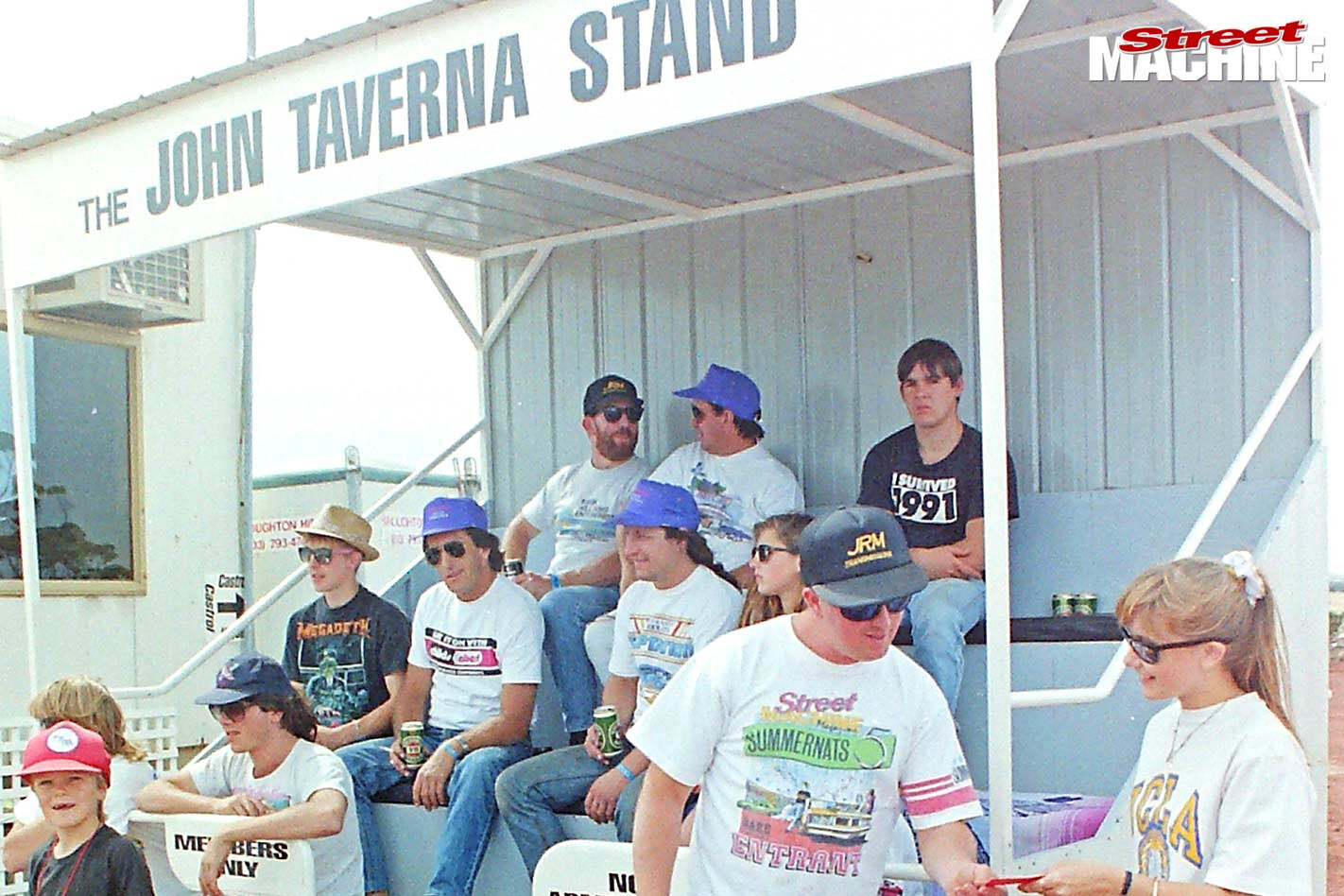 John set up his own mini-grandstand for the 1992 Nationals at Calder Park.
John set up his own mini-grandstand for the 1992 Nationals at Calder Park.
We laughed at the irony of our spot in that box; John was as far from a celebrity as you could get, happy to give everyone his time and advice, with his signature smile and friendly nature. I loved hanging out at his workshop in Leo Street on a Friday afternoon — lots of stories and lots of coldies were had.
We shared many passions — cars, swap-meets, family and Sambuca. We always had a bloody good laugh on our many trips around the country and I loved our chats that lasted for hours. I smile when I recall our trip to Rottnest Island, WA, after Motorvation. Johnny got seasick and had a chuck over the side of the boat but he lost his sunglasses and cracked us all up!
Cruising in our Caddy at the Bright Hot Rod Run, we spotted John sitting in his chair. When we pulled up and threw him the keys, his smile was worth 1000 words and it’s a smile that will be with us forever.
I know I can say I’m a better man for having known John Taverna; he was like a second father to me in the street machine world and always helped without expecting anything in return. He was a man with a heart as big as his smile and he will be greatly missed.
DAVID COOK
WHEN it comes to building cars, it helps if you’ve been a racer because you can appreciate the stresses the cars will go through. That was John Taverna’s secret.
John started racing his ’57 Chev streeter after seeing the sport at the old Riverside strip near Melbourne in the mid-1960s. His serious racing began in early 1975, when he debuted an FJ with 327 Chev power in partnership with Phil Facciolo, under the name The Grot.
John Taverna & Phil Facciolo
The car was soon running below the B/Gas record and did the same in C/Gas when fitted with a 283.
It wasn’t until mid-’77 that he won a meeting — the 1977 Sportsnationals, in his new 302 Monaro C/Gasser — and picked up his first trophy.
In 1979 he went solo and built an A/G 302 Torana, then a B/G 331 VH Commodore in 1982.
All this time he had been working as a forklift driver at Ford while his race skills had been bringing him after-hours work doing chassis, ladder bars and wheel tubs.
By 1982, life with two jobs had become too hectic, so in a shed in his father’s backyard he launched John Taverna Chassis. But he was soon just as busy, working round the clock, seven days a week. With as many as 20 cars in his workshop, he moved to a factory nearer his home.
Taverna’s workshop turned out many great race cars of the 1980s and 90s; probably the best known would be Peter Kapiris’s AA/Gas Beretta.
Kapiris went to Taverna for a new street car but Taverna talked him into taking the pile of Beretta panels he had bought and building a real race car. It was one of the most outstanding builds of the 90s and it hooked Kapiris on drag racing — he’s now one of the sport’s enduring stars, with his string of Top Doorslammers.
The racing brought Taverna a national record in 1983, and with his new 331 Camira B/Gasser he continued his involvement with the quarter-mile.
In 1985 he stepped up to Pro Stock with a new JD Camira making final round placings, but his growing involvement with ANDRA as Victorian divisional director and deputy national director eventually forced him to make a choice, and in 1990 he quit racing.
“When I took on the national director’s job in 1988, he provided fabulous support,” former ANDRA CEO Tony Thornton recalls. “Just before that, I remember a meeting in Melbourne — at John’s kitchen table — where he, Kevin Prendergast, Bruce Casos and I faced the Bob Jane challenge for the first time, and the fact that ANDRA was effectively bankrupt.
JT with long-serving ANDRA national director and later CEO, Tony Thornton. John served both as the Victorian divisional director and as deputy national director
“John contributed a great deal to the sport of drag racing — the recovery of ANDRA in the 80s, the operation of events in Melbourne and Heathcote, and many state-of-the-art sedan race cars. For us he leaves a solid legacy.”
THE TAVERNA BROTHERS
The Taverna brothers — John Jr, Robert and Jason — reflect on their Dad, ‘Jack’
OUR father was a man of many talents. He was daring, crazy, adventurous, intelligent and always a very hard worker.
It all started from what we Taverna boys called Argyle St. This was our grandparents’ house, where Dad would paint, panel-beat and do mechanical work. He also bought and sold cars, and did all of this while he still had a full-time job at Ford.
His love of cars turned into a passion for drag racing, so Dad purchased a black ’57 Chev; four-door pillarless, 283, four-speed. As the passion grew, he swapped the Chev (as a roller) for an FJ race car, to which we fitted the motor from the ’57.
At his first meeting at Calder, Jack (as we called him in the workshop) broke the B/G record and this was the start to a long and successful career as a drag racer. We then built an HK, an LX hatchback, a VB Commodore and later a Holden Camira.
After the Camira we started on a Chev Beretta but Dad said: “No more race cars; we’re going to build street machines.” He sold the Beretta to Peter Kapiris.
Our first street machine build was Dad’s pink LJ Torana; it had a 308, Powerglide and semi-tubs. It was followed by the pink ’67 Camaro, the yellow ’67 fastback and finally the green Ranchero ute.
As a family growing up and working together, we had our fair share of conflict. However, John Taverna was our dad, he was our children’s grandfather, and he has left an irreplaceable void in our lives.
Rest in peace, Dad.
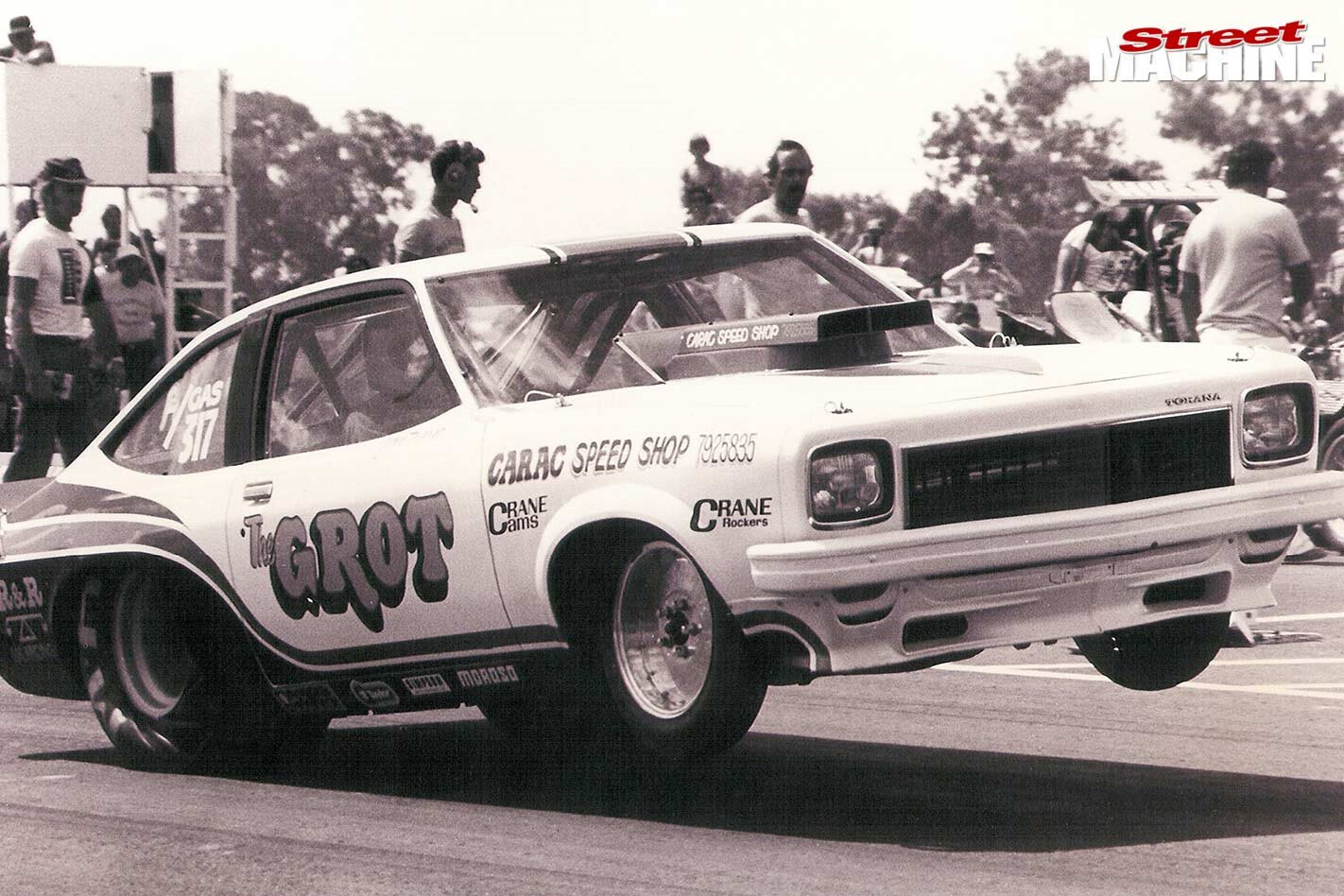
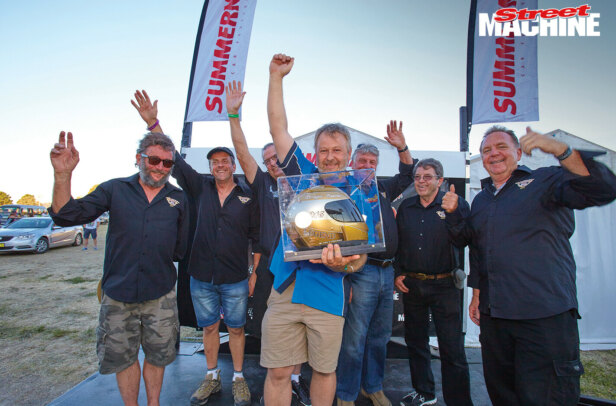
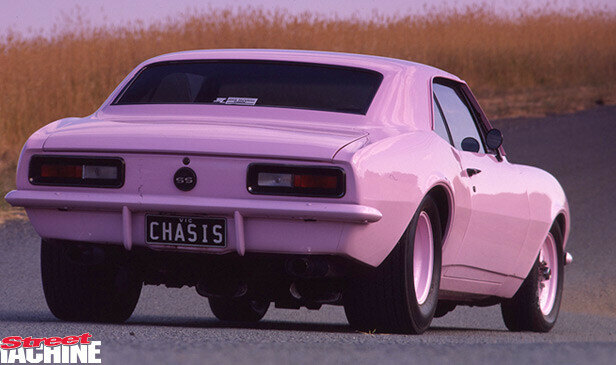
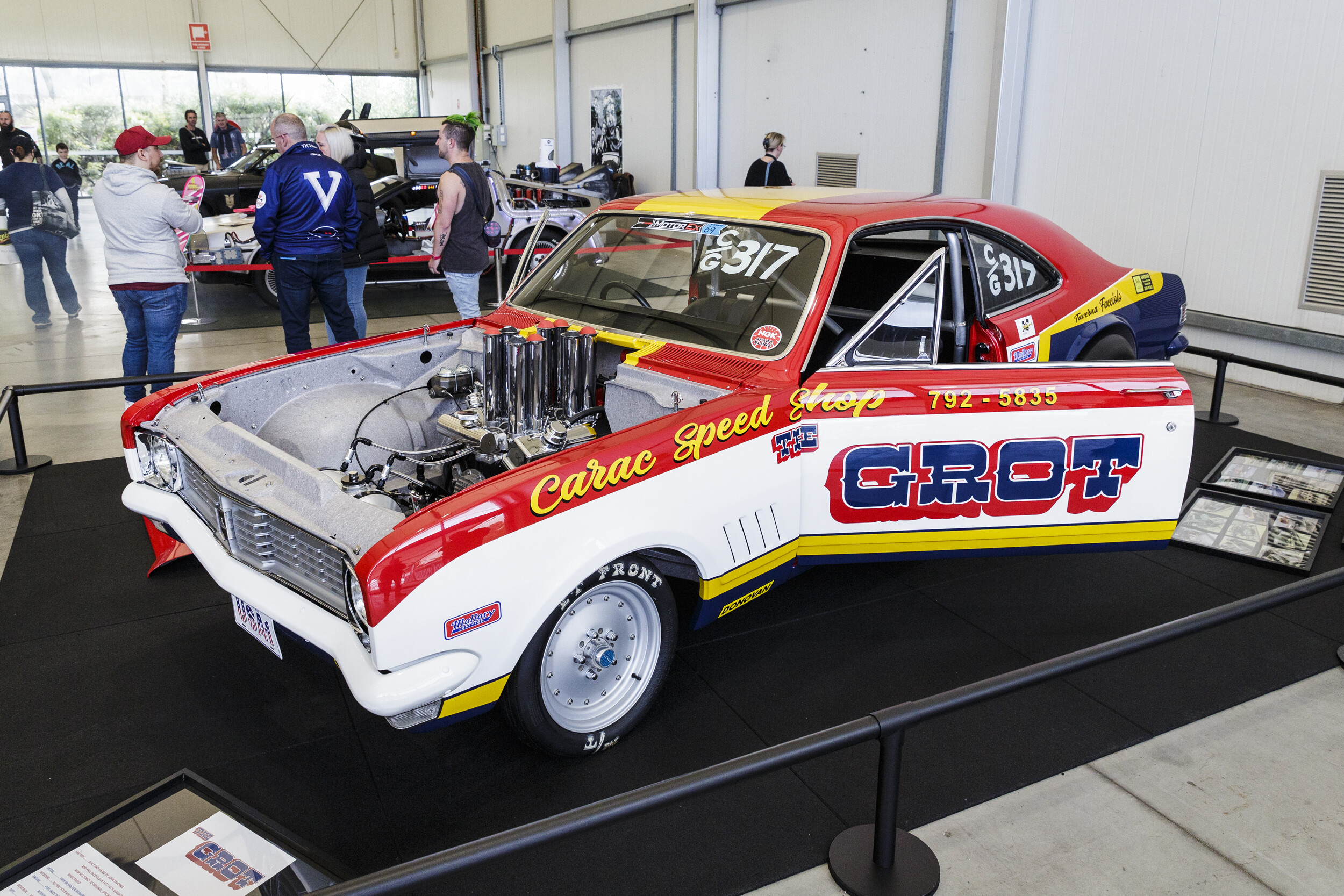
Comments